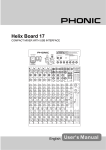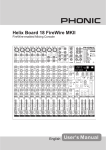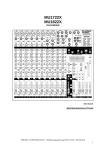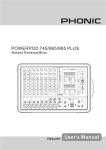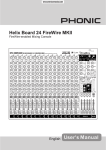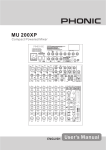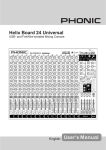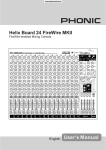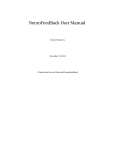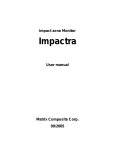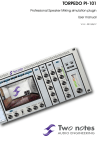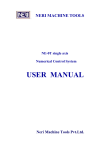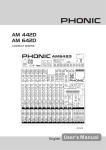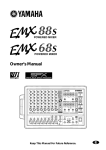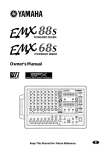Download User`s Manual Helix Board 18 FireWire
Transcript
Helix Board 18 FireWire 18-Input 2-Subgroup FireWire Mixer ENGLISH User's Manual IMPORTANT SAFETY INSTRUCTIONS The apparatus shall not be exposed to dripping or splashing and that no objects filled with liquids, such as vases, shall be placed on the apparatus. The MAINS plug is used as the disconnect device, the disconnect device shall remain readily operable. Warning: the user shall not place this apparatus in the confined area during the operation so that the mains switch can be easily accessible. 1. Read these instructions before operating this apparatus. 2. Keep these instructions for future reference. 3. Heed all warnings to ensure safe operation. 4. Follow all instructions provided in this document. 5. Do not use this apparatus near water or in locations where condensation may occur. 6. Clean only with dry cloth. Do not use aerosol or liquid cleaners. Unplug this apparatus before cleaning. 7. Do not block any of the ventilation openings. Install in accordance with the manufacturer’s instructions. 8. Do not install near any heat sources such as radiators, heat registers, stoves, or other apparatus (including amplifiers) that produce heat. 9. Do not defeat the safety purpose of the polarized or grounding-type plug. A polarized plug has two blades with one wider than the other. A grounding type plug has two blades and a third grounding prong. The wide blade or the third prong is provided for your safety. If the provided plug does not fit into your outlet, consult an electrician for replacement of the obsolete outlet. 10. Protect the power cord from being walked on or pinched particularly at plug, convenience receptacles, and the point where they exit from the apparatus. 11. Only use attachments/accessories specified by the manufacturer. 12. Use only with a cart, stand, tripod, bracket, or table specified by the manufacturer, or sold with the apparatus. When a cart is used, use caution when moving the cart/apparatus combination to avoid injury from tip-over. 13. Unplug this apparatus during lighting storms or when unused for long periods of time. 14. Refer all servicing to qualified service personnel. Servicing is required when the apparatus has been damaged in any way, such as power-supply cord or plug is damaged, liquid has been spilled or objects have fallen into the apparatus, the apparatus has been exposed to rain or moisture, does not operate normally, or has been dropped. CAUTION: TO REDUCE THE RISK OF ELECTRIC SHOCK, DO NOT REMOVE COVER (OR BACK) NO USER SERVICEABLE PARTS INSIDE REFER SERVICING TO QUALIFIED PERSONNEL The lightning flash with arrowhead symbol, within an equilateral triangle, is intended to alert the user to the presence of uninsulated “dangerous voltage” within the product’s enclosure that may be of sufficient magnitude to constitute a risk of electric shock to persons. The exclamation point within an equilateral triangle is intended to alert the user to the presence of important operating and maintenance (servicing) instructions in the literature accompanying the appliance. WARNING: To reduce the risk of fire or electric shock, do not expose this apparatus to rain or moisture. CAUTION: Use of controls or adjustments or performance of procedures other than those specified may result in hazardous radiation exposure. Helix Board 18 FireWire 18-Input 2-Subgroup FireWire Mixer page Introduction.........................................................................................4 Getting Started...................................................................................5 Channel Setup....................................................................................5 Making Connections...........................................................................6 Inputs and Outputs..........................................................................6 Rear Panel. ...................................................................................7 Controls and Settings.........................................................................7 Rear Panel. ...................................................................................7 Channel Controls............................................................................7 Digital Effect Engine........................................................................9 Master Section...............................................................................9 FireWire Interface.............................................................................12 System Requirements...............................................................................12 Driver Installation.......................................................................................12 Channel Assignment.................................................................................16 Cubase LE.................................................................................................16 Helix Board Control Panel.........................................................................17 Digital Effects Table..........................................................................19 Application........................................................................................20 Specifications...................................................................................22 Dimensions.......................................................................................24 Block Diagram..................................................................................25 Phonic reserves the right to improve or alter any information supplied within this document without prior notice. V1.0 7/1, 2005 Introduction Features Thank you for choosing one of Phonic's many quality compact mixers. The Helix Board 18 FireWire mixing console - designed by the talented engineers that have created a variety of mixers fantastic in style and performance in the past - displays similar proficiency that previous Phonic products have shown; with the addition of such innovative features as FireWire interface. The Helix Board 18 FireWire features full gain ranges, amazingly low distortion levels, and incredibly wide dynamic ranges - just showing the dominance these small machines will have in the mixing World. • 18-input small-format analog mixer with extremely The FireWire interface of the Helix Board 18 FireWire allows users to stream up to 16 individual channels to any PC or Mac, allowing for recording, editing, tweaking and removal of all tracks at will. Then when all your adjustments are made, your final product can be burnt onto CD. Also included with the Helix Board 18 FireWire mixer is Steinberg Cubase LE software, giving users a taste of the operation of professional Digital Audio Workstation software by allowing users to record up to 4 tracks simultaneously. Other high performance Digital Audio Workstation software will allow upto 16 channels to be simultaneously streamed and recorded. All-in-all, the Helix Board 18 FireWire will no doubt prove itself to have been a valuable investment. We know how eager you are to get started - wanting to get the mixer out and hook it all up is probably your number one priority right now - but before you do, we strongly urge you to take a look through this manual. Inside, you will find important facts and figures on the set up, use and applications of your brand new mixer. If you do happen to be one of the many people who flatly refuse to read user manuals, then we just urge you to at least glance at the Instant Setup section. After glancing at or reading through the manual (we applaud you if you do read the entire manual), please store it in a place that is easy for you to find, because chances are there is something you missed the first time around. page low noise circuitry • 96 kHz FireWire interface for streaming 16 independent channels of audio to computer with near-zero latency • Compatible with Mac OS X and Windows XP • Steinberg Cubase LE workstation software included • Two channels of monitoring from computer via FireWire interface, can be assigned to control room monitors, main mix and AUX 1 • DFX, our 24-bit digital multi-effect processor with 16 programs plus one main parameter control, tap control and foot switch jack • Six Mic/Line channels with inserts • 8 Mic preamps • Four stereo Line channels • 3-band EQ with swept mid-range • 75 Hz low-cut filter on mono channels • Three AUX sends, one with Pre/Post switch • Two stereo AUX returns with effect to monitor level control • Mini Stereo I/O and stereo RCA I/O each with trim control • +48V phantom power on Mic channels • Solo feature on each input and output • Stereo 10-band graphic EQ, assignable to main mix or AUX 1 send • Two true subgroups with main L and R routing switches • Rec out with trim control for recording level matching • Built-in switching power supply with universal connector, 100-240 VAC, 50/60 Hz • Rack-mounting kit included Helix Board 18 FireWire User's Manual PHONIC CORPORATION Getting Started Channel Setup 1. Ensure all power is turned off on your mixer. To totally ensure this, the AC cable should not be connected to the unit. 1. 2. All faders and level controls should be set at the lowest level and all channels switched off to ensure no sound is inadvertently sent through the outputs when the device is switched on. All levels can be altered to acceptable degrees after the device is turned on. To ensure the correct audio level of the input channel is selected, each of the Mixer’s Channel’s ON buttons should be disengaged (which should turn the corresponding LED indicator off), as well as the SOLO buttons on each channel and 2T RTN “To Ctrl Rm”. 2. Ensure the channel you wish to set has a signal sent to it similar to the signal that will be sent when in common use. For example, if the channel has a microphone connected to it, then you should speak or sing at the same level the performer normally would during a performance; if a guitar is plugged into the channel, then the guitar should also be strummed as it normally would be (and so on). This ensures levels are completely accurate and avoids having to reset them later. 3. Move the Channel fader and Maser fader to around the 0 dB mark. 4. Turn the Channel ON. 5. Pushing the channel’s SOLO button and releasing the Pre/Post button on the CTRL RM section will send the pre-fader signal of the activated channel to the Control Room / Phones mixing bus and the Level Meter will display the Control Room’s signal properties. 6. Set the gain so the level meter indicates the audio level is around 0 dB (it is advisable to never let the level exceed 7 dB). 7. This channel is now ready to be used; you can stop making the audio signal. 8. You can now repeat the same process for other channels if you wish. 3. Plug all necessary instruments and equipment into the device’s various inputs as required. This may include line signal devices, such as keyboards and drum machines, as well as microphones and/or guitars, keyboards, etc. 4. Plug any necessary equipment into the device’s various outputs. This could include amplifiers and speakers, monitors, signal processors, and/ or recording devices. 5. Plug the supplied AC cable into the AC inlet on the back of the device and a power outlet of a suitable voltage. 6. Turn the power switch on. 7. Consult the FireWire section of this manual for more information on its setup and usage. PHONIC CORPORATION Helix Board 18 FireWire User's Manual page Making Connections Inputs and Outputs 1. XLR Microphone Jacks These jacks accept typical 3- 1 pin XLR inputs for balanced and unbalanced signals. They can be 2 used in conjunction with microphones – such as professional condenser, dynamic or ribbon microphones – with standard XLR male connectors, and feature low noise preamplifiers, serving for crystal clear sound replication. The Helix Board 18 FireWire features a total of eight Microphone inputs. NB. When these inputs are used with condenser microphones, the Phantom Power should be activated. However, when Phantom Power is engaged, single ended (unbalanced) microphones and instruments should not be used on the Mic inputs. 2. Line Inputs This input accepts typical 1/4" TRS (balanced) or TS (unbalanced) inputs, for balanced or unbalanced signals. They can be used in conjunction with a wide range of line level devices, such as keyboards, drum machines, electric guitars, and a variety of other electric instruments. 3. Stereo Channels The Helix Board 18 FireWire also features a few stereo channels, thrown in for maximum flexibility. Each of these stereo channels features two 1/4" phone jacks, for the addition of various line level input devices, such as electronic keyboards, guitars and external signal processors or mixers, as well as XLR Microphone jacks on channels 7/8 and 9/10, allowing users to option of using the channel as a microphone input channel. If you wish to use a monaural device on a stereo input, simply plug the device’s 1/4" phone jack into the left (mono) input and leave the right input bare. The signal will be duplicated to the right due to the miracle of jack normalizing. 4. AUX Returns These 1/4" TS inputs are for the return of audio to the Helix Board 18 FireWire mixer, processed by an external signal processor. If really needed, they can also be used as additional inputs. The 4 feed from these inputs can be adjusted using the AUX Return controls on the face of the mixer. When connecting a monaural device to the AUX Return 1 and 2 inputs, simply plug a 1/4" phone jack into the left (mono) input, and the signal will appear in the right as well. NB. When any device is plugged into the mixer’s AUX Return 2, the mixer’s internal digital effect engine is then disabled. page 5. AUX Sends These 1/4" TRS outputs may be used to connect to an external signal processor, or even to an amplifier and speakers (depending on your desired settings) from the mixer. The signal from the AUX 5 Sends is controlled by the AUX master controls (on the face of the mixer), which obtain their signal from the AUX controls located on each channel strip. The Helix Board 18 FireWire features a total of 3 AUX Sends. When using the FireWire interface, AUX Send 1 can be elected to receive the audio signal sent from the Computer, for monitoring or recording purposes. 6. Foot Switch Jacks These ports are for the inclusion of an unlatched foot switch, used to remotely adjust properties of the built-in Digital Effect processor. The uppermost jack is used to turn the Digital Effects on and off, where the lower jack is used for adjusting tap delay properties. 6 7. Phones This stereo output port is suited for use with headphones, allowing monitoring of the mix. The audio level of this output is controlled using the Control Room / Phones control. 8. Record Out 10 These outputs will accommodate RCA cables, able to be fed to a 8 variety of recording devices. Also included is a mini stereo jack for 9 the addition of recording devices 7 such as MD players, and even laptop computers. The Trim Control allows you to adjust the output level of the record out and the Main Left and Right mix sent to the FireWire interface, between –10 to +10 dB, making level matching in recording much easier. 9. 2T Return These RCA inputs are used to connect the mixer with parallel external devices, such as sub mixers or CD, Tape and Cassette Players. Also included are mini stereo jacks, for receiving signals from audio devices like portable CD, MD and MP3 players. 10. Main Out These two balanced 1/4" TRS phone jacks will output the final stereo line level signal sent from the main mixing bus. The primary purpose of these jacks is to send the main output to external devices, which may include power amplifiers (and in-turn, a pair of speakers), other mixers, as well as a wide range of other possible signal processors (Equalizers, Crossovers, etcetera). Helix Board 18 FireWire User's Manual PHONIC CORPORATION Rear Panel 16. Power Connector 11. Channel Inserts Located on the rear of the Helix Board 18 FireWire, the primary use for these TRS phone jacks is for the addition of external devices, such as dynamic processors or equalizers, to mono input channels 1 through to 6. This will require a Y cord that can send (pre-fader and pre-EQ) and receive signals to and from an external processor. The tip of the TRS plug is for sending of the signal to the external device, the ring is for return of the signal to the Helix Board 18 FireWire, and the 11 Sleeve is the grounding. 12. Control Room Outputs These two 1/4" phone jack outputs feed the signal altered by the Control Room / Phones level control on the face of the mixer. This output has extensive use, as it can be used to feed the signal from the mixer to an active monitor, for the monitoring of the audio signal from within a booth, or, alternatively, for the addition of external signal processing devices or mixers, as well as acting as a “side fill” output, supplying audio to indoor areas that the main speakers do not reach. When using the FireWire interface, this output can be elected to be fed the audio signal from the Computer, for monitoring of recording audio. 13 12 13. Group Out These balanced 1/4" TRS phone jacks output the final feed from the Group 1 and 2 Faders on the main mixer. These outputs can be used to feed a wide range of devices, such as mixers, signal processors, and even to connect an amplifier and speakers to be used along with the Main Speakers, for a more rounded audio experience. 14. Main Out 15 14 These two XLR ports will output the final stereo line level signal sent from the main mixing bus. The primary purpose of these jacks is to send the main output to external devices, which may include power amplifiers (and in-turn, a pair of speakers), other mixers, as well as a wide range of other possible signal processors (equalizers, crossovers, etcetera). 15. FireWire Connections The two FireWire connectors are for linking the Helix Board 18 FireWire to a PC or Macintosh computer. It will allow 16 channels to be streamed to the computer (the amount of channels you are able to record simultaneously depends on the DAW software used), and 2 audio channels of the computer to be returned to the mixer. Please observe the FireWire section of this manual for more information. PHONIC CORPORATION This port is for the addition of a power cable, allowing power to be supplied to the mixer. Please use the power cable that is included with this mixer only. The Helix Board 18 FireWire features a switching power supply, suitable for all zones. 16 Controls and Settings Rear Panel 17. Phantom Power Switch 18 17 When this switch is in the on position, it activates +48V of phantom power for all microphone inputs, allowing condenser microphones (well, the ones that don’t use batteries) to be used on these channels. Activating Phantom Power will be accompanied by an illuminated LED above the left channel Level Meter. Before turning Phantom Power on, turn all level controls to a minimum to avoid the possibility of a ghastly popping sound from the speakers. NB. Phantom Power should be used in conjunction with balanced microphones. When Phantom Power is engaged, single ended (unbalanced) microphones and instruments should not be used on the Mic inputs. Phantom Power will not cause damage to most dynamic microphones, however if unsure, the microphone’s user manual should be consulted. 18. Power Switch This switch is used to turn the mixer on and off. Ensure you turn all level controls down before activating. Channel Controls 19. Low Cult Filter (75 Hz) This button will activate a high-pass 19 filter that reduces all frequencies below 75 Hz at 18 dB per Octave, 20 helping to remove any unwanted ground noise or stage rumble. On stereo channels 7/8 and 9/10, the low cut filter affects only the XLR Microphone inputs (and not the line inputs). 20. Line/Mic Gain Control This controls the sensitivity of the input signal of the Line/Microphone input. The gain should be adjusted to a level that allows the maximum use of the audio, while still maintaining the quality of the feed. This can be accomplished by adjusting it to a level that will allow the peak indicator occasionally illuminate. 21. High Frequency Control This control is used to give a shelving 21 boost or cut of ±15 ������������������������� dB to high frequency (12 kHz) sounds. This will adjust the amount of treble included in the audio of the channel, adding strength and crispness to sounds such as guitars, cymbals, and synthesizers. Helix Board 18 FireWire User's Manual page 22. Middle Frequency Control This control is used to provide a peaking style of boost and cut 21 to the level of middle frequency sounds at a range of ±15 �������� dB. 22 These mixers also provide a sweep control, allowing you to 23 select a center frequency between 100 Hz and 8 kHz. Changing 24 middle frequencies of an audio feed can be rather difficult when used in a professional audio mix, 25 as it is usually more desirable 26 to cut middle frequency sounds 27 rather than boost them, soothing overly harsh vocal and instrument sounds in the audio. Stereo channels 11/12 and 13/14 of the Helix Board 18 FireWire feature a High-Mid and Low-Mid control instead of the typical controls described above. They provide a peaking style of boost and cut to middle frequencies, where the frequencies are set at 3 kHz and 800 Hz (High-Mid is set at 3 kHz and Low-Mid is set at 800 Hz). Stereo channels 9/10 and 11/12 have a single Middle Frequency control, with the center frequency set at 2.5 KHz. 26. Pan / Balance Controls This alternates the degree or level of audio that the left and right side of the main mix should receive. On mono channels, the PAN control will adjust the level that the left and right should receive (pan), where as on a stereo channel, adjusting the BAL control will attenuate the left or right audio signals accordingly (balance). 27. On Button and Indicator This turns the channel on, allowing the user to use the feed from the channel’s inputs to supply the MAIN L/R, GROUP 1/2, AUX and EFX buses. The corresponding indicator will be illuminated when turned on. 28. 1-2 and L-R Buttons These handy buttons allow you to decide the audio path of the corresponding channel. Pushing the “1/2” button allows the signal to be sent to the Group 1/2 mix, where the “L-R” allows it to be sent to the Main L/R mix. 29. Peak Indicator 23. Low Frequency Control This control is used to give a shelving boost or cut of �������������������������������������������������� ±15 dB to low frequency (80 Hz) sounds. This will adjust the amount of bass included in the audio of the channel, and bring more warmth and punch to drums and bass guitars. This LED indicator will illuminate when the channel hits high peaks, 6 dB before overload occurs. It is best to adjust the channel level control so as to allow the PEAK indicator to light up on regular 31 intervals only. This will ensure a greater dynamic range of audio. This indicator also doubles as a Solo indicator, when the SOLO button is engaged. 24. AUX Control 30. Solo Button This control alters the signal level that is being sent to the auxiliary 1 mixing bus, the signal of which is suitable for connecting stage monitors, allowing artists to listen to the music that is being played. Also included is a Pre/Post button, which alternates the feed to the AUX 2 mixing bus between a post and prefader feed. 25. EFX Control This control alters the signal level that is sent to the EFX send (AUX 3) output and the built-in digital effect processor. The EFX send signal can be used in conjunction with external signal processors (this signal of which can be returned to mixer via the AUX return input), or simply as an additional auxiliary output. page 28 29 30 The Solo button is pushed to allow the signal of a corresponding channel to be sent to the Control Room / Phones control (pre or post fader, depending on the properties selected by the pre / post button, located by the Control Room / Phones control), for use with either headphones or studio monitors. This also allows easier setting of the input gain and tracking of audio by sound engineers. The Peak indicator above the Solo button also doubles as a Peak Indicator, illuminating when the signal reaches high peaks. 31. Channel Level Control (Fader) This control will alter the signal level that is sent from the corresponding channel to the appropriate mixing buses (whether they are the MAIN L/R or AUX). Helix Board 18 FireWire User's Manual PHONIC CORPORATION 32. +4 / -10 Buttons These buttons, located on each stereo input channel, are used adjust the input sensitivity of the corresponding channel, which will adapt the mixer to external 32 devices which may use different operating levels. If the input source is -10 dBV (consumer audio standard), it is best to engage the switch, allowing the signal to be heard. If the input source is +4 dBu (professional audio standard) the corresponding input channel’s button should be disengaged to ensure the integrity of the Mixer’s circuitry. If you are unsure of the source’s operating level, we suggest leaving the switch disengaged until you test the source’s signal. You can then engage if necessary (if the level of input is obviously too low). Digital Effect Engine 37. Parameter Control This will adjust the one main parameter of the digital effect program that is applied to the audio feed. Please refer to the Digital Effects Table for more information on Effect parameters. NB. The digital effect engine has a “memory” function, which allows you to adjust the parameters of a program, then, if you change the parameters of another program and return to the original one, your parameter setting will be kept until the Parameter Control is turned once again, at which time it will be altered according to the control. 38. Tap Delay Button and Indicator When the tap delay program is selected, this button is used to determine the delay time. By pushing the button several times, the effect engine interprets the time between last two pushes and remembers this as the delay time until the button is pushed again. When the tap delay effect is selected, the corresponding LED will flash at the intervals selected. 33. Digital Effect Display This panel displays the titles of different effects that can be added to audio. When you select the effect, the name will illuminate, and the alteration be applied automatically. For a list of available effects, please observe the Digital Effect Table. Master Section 39. AUX Return Control 33 34. Program Control This control is used to scroll through the various effects shown on the Digital Effect Display. Turning the control will automatically change the effect and apply it to the mix. To see the list of available programs, please check the Digital Effect Table. 35. Peak Indicator This LED indicator will illuminate when the device hits high peaks. It is best to adjust the EFX Send Controls (on all Input Channels and the Master Section) so as to ensure the Peak indicator does not light up at all. This will ensure a greater dynamic range for audio. 36. Effect On Button and Indicator This button is pushed to turn the corresponding effect panel on or off. When the effect processor is turned on, the corresponding LED illuminates. 37 34 35 36 38 PHONIC CORPORATION This control adjusts the signal level of audio fed through to the stereo AUX 1 Return input. Each AUX return control also features a SOLO button, which sends the signal to the Control Room / Phones mixing bus, most commonly for monitoring purposes. The accompanying “To AUX 1” control allows users to adjust the volume of that particular signal that is sent to the AUX 1 send mixing bus. 39 40. EFX Return Control This 60mm fader adjusts the signal level of audio fed through to stereo AUX Return 2 inputs. If no device is plugged into the AUX Return 2 inputs, this control then acts as the final level control of the built-in Digital Effect Engine. The EFX Return Control also features a SOLO button, which allows users to send the signal to the Control Room / Phones mixing bus. There is also a 1-2 button, which sends the signal to the Group 1 and 2 mixing bus, as well as a L-R button, which sends the signal to the 40 Main L-R mixing bus. The accompanying “To AUX 1” control allows users to adjust the volume of that particular signal that is sent to the AUX 1 send mixing bus. An on button and indicator also accompanies this control, allowing users to mute and activate the channel at will. Helix Board 18 FireWire User's Manual page 41. AUX Send Master Control This control adjusts the final level of the AUX mixing bus (as taken from the AUX level controls on each channel strip), the audio of which is sent to AUX Send 1 output. The corresponding SOLO button allows you to send the AUX Send signal to the Control Room / Phones mixing bus. The Helix Board 18 FireWire has 2 AUX sends, where the first is in fact a 60mm fader, rather than the typical rotary control. Also incorporated with the AUX 1 control is an ON button and indicator, allowing AUX 1 to be activated and muted by the push of a button. Activation of the AUX 1 channel is accompanied by an illuminated LED. 45. FireWire Assign Buttons These three buttons allow users to select the destination of the audio signal received through the FireWire interface. They are pretty straight forward, the “To Ctrl Rm” button allows the signal to be sent to the Control Room mixing bus, the “Assign to Main” button allows users to send the signal to the Main L-R mixing bus, and the “Assign to AUX 1” button allows users to send the signal to the AUX 1 mixing bus. It couldn’t be simpler! 46. 2T Return Controls 41 42. EFX Send Master Control This control adjusts the final level of the EFX mixing bus (as taken from the EFX level controls on each channel strip), the audio of which is sent to the AUX Send 42 3 outputs, as well as the built-in digital effect engine. The corresponding SOLO button allows you to send the signal to the Control Room / Phones mixing bus. 43. Control Room / Phones Controls This control is used to adjust the audio level of the Phones feed, as well as the signal sent to the Control Room output, for use in monitoring and tracking of audio. Below is a table showing the priority of the signals received by the Control Room / Phones mixing bus. If the first priority signal is not available, the second priority signal will be used, and so forth. Priority Signal 1 st From Solo 2 nd FireWire Interface Signal 3rd 2T Return to Control Room 4 Main L/R th 44. Pre / Post Control This button alternates the Control Room / Phones source signals between those of post-fader and prefader feeds. 43 46 44 45 page 10 Turning the 2T Return level control adjusts the signal level of the feed from the 2T Return inputs. Pushing either one of the buttons in the 2T Return Control Section selects the destination of the 2T Return signal. The uppermost button (“to Ctrl Rm”) sends the signal to the Control Room/Phones mixing bus, whereas the lower button (“to L/R”) sends the signal to the Main LR mixing bus. These buttons can, of course, be used simultaneously, feeding the signal to both the Control Room/Phones and Main L/R mixing bus. Please note, that when the "to L/R" button is pressed, there is no signal from the record output. 47. +48V Indicator This indicator will illuminate when Phantom Power is activated. 48. Power Indicator The Power Indicator will light up when the power of the mixer is on. 49. Level Meter This dual 13 segment level meter 47 48 gives an accurate indication of when audio levels of the Main L/R output reach certain levels. The 0 dB indicator illuminates is approximately equal to an output level of +4 dBu (balanced), and the PEAK indicator illuminates about 1.5 dB before the signal is dynamically clipped. It is 49 suggested for the maximum use of audio to set the various levels controls so that it sits steadily around 0 dB to make full use of audio, while still maintaining fantastic clarity. When the Solo indicator, located beside the Level Meter, is illuminated, one or more Solo buttons has been pushed. In that case, the Level meter will display properties of the Solo signal, which is helpful with setting of channel properties. If Solo indicator illuminates green, this means the Solo feed is a prefader signal. If the solo indicator illuminates red, the feed is post-fader. If the no Solo buttons are activated, Helix Board 18 FireWire User's Manual PHONIC CORPORATION the FireWire signal properties are displayed by the Level Meter. Then, if no signal is received through the FireWire interface, the 2T return signal will be displayed. If the 2T return signal is not present, the Main L/R signal is then displayed. Priority Signal 1 st From Solo 2 nd FireWire Interface Signal 3rd 2T Return to Control Room 4 Main L/R th 53. Record Out Trim Control The Trim Control allows you to adjust the output level of the record out and 53 the Main Left and Right mix sent to the FireWire, between –��������������������������� 10������������������������� to +10 dB, making level matching in recording much easier. Use this control to ensure excessive levels are not sent to Digital Recording or Editing devices, allowing the device to be used efficiently without the possibility of error. 50. Group 1/2 Controls These two faders are the final level control for the Group 1 and 2 audio feeds, sent to the Group 1 and 2 outputs. These faders can be fed a signal from the various mono and stereo channels, as well as EFX Returns, depending on your selections. When pushed all the way up, these faders provide 10 dB of gain to the signal, and, when set all the way down, effectively mute 50 the signal. The Group Controls also feature Left, Right and Solo buttons, which allow you to send the Group 1/2 signal to the Main Left and Right, and the Control Room / Phones mixing buses, respectively. 51. Main L/R Faders These two faders are the final level control for the Main Left and Right audio feeds, sent to the Main L and R outputs. These faders are possibly fed by the various mono and stereo channels, as well as AUX and EFX returns and 2T inputs, depending on the your selections. When pushed all the way up, these faders provide 10 dB of gain to the signal, and, when set all the way down, effectively mute the signal. 51 52. Graphic Equalizer This stereo, 10 band graphic equalizer allows the user to adjust the frequency response of a signal, with a maximum of ±12 ������������������������������������������ dB of signal boost�������������������� or cut for each of the frequencies. The AUX 1 / MAIN switch alternates the use of the equalizer between the use of the AUX 1 bus and MAIN L/R bus signals, respectively. Pushing the on button in activates the equalizer, which is accompanied by an illuminated LED. 52 PHONIC CORPORATION Helix Board 18 FireWire User's Manual page 11 FireWire Interface System Requirements The following are the minimum required specifications for use with the Helix Board FireWire mixer. If your computer does not meet these requirements, you will experience lagging of audio and possible freezing of your computer when attempting to operate the mixer. Windows • Microsoft�� ® ��������� Windows® �������������� XP������������ SP1 and SP2 • Available FireWire port • Intel Pentium�� ® ���������������������������������������������� 4 processor or equivalent AMD Athlon processor • Motherboard with Intel or VIA chipset 5400 RPM or faster hard disk drive (7200 RPM or faster with 8 MB cache recommended) • 256 MB or more of RAM (512 MB recommended) Macintosh • OS X 10.3.5 or later with native FireWire support • G4 or newer processor • 256 MB or more of RAM Driver Installation To use the Helix Board FireWire mixer efficiently (or at all) on a PC, it is important to install all the necessary drivers from the included CD (ASIO and WDM drivers). It is important that users read all instructions carefully before continuing on to the each step of installation, as users will be required to unplug and plug in their FireWire device. This is not necessary for Mac users. Windows XP (with Service Pack 1 or 2) 1. 2. 3. 4. It is recommended that you quit all applications before starting the installation process. Ensure the Helix Board FireWire is not yet connected to your Computer’s FireWire input. Insert the installation CD included with your Helix Board FireWire mixer into the CD-ROM drive of your computer. If the CD does not automatically start the installation process within a few moments, then navigate to "My Computer" your CD-ROM drive "Drivers and Control Panel" double-click “setup.exe” to begin the installation manually. The Helix Board FireWire Control Panel software also will be installed at this time. Follow the installation instructions. Make sure no other programs are running on your PC and that the Helix Board 18 is not connected to your PC, then click "Next". page 12 Helix Board 18 FireWire User's Manual PHONIC CORPORATION Read and accept the terms of the License Agreement and click "Yes" to continue. Either select a new destination for the installation, or else click "Next" to accept the default directory. Click "Next" to begin the installation. PHONIC CORPORATION Helix Board 18 FireWire User's Manual page 13 Connect the Helix Board FireWire to the Computer and turn the power on. If a message is displayed indicating that the software has not passed Windows Logo test, click “Continue Anyway”. After installation is complete, users are free to use the device as they wish. page 14 Helix Board 18 FireWire User's Manual PHONIC CORPORATION Macintosh OS X (10.3.5 or later) The Helix Board 18 FireWire works with the primary audio drivers of Macintosh OS X 10.3.5 and later. First verify that you are running Macintosh OS X 10.3.5 or above, then connect the Helix Board 18 FireWire to a FireWire port to the computer. To ensure your Helix Board 18 FireWire is working, enter the Utilities folder and double-click the Audio MIDI Setup icon. Enter the Audio Device's section. From the "Properties for" pull-down tab, select Helix Board 18 FireWire. At the bottom of the window, users can edit the setup of the Helix Board 18 FireWire. Properties such as sampling rate and clock source can be altered. Users may also opt to make the Helix Board 18 FireWire their default input and/or output device. Mac users are able to use GarageBand Digital Audio Workstation Software, in conjunction with the Helix Board 18 FireWire. PHONIC CORPORATION Helix Board 18 FireWire User's Manual page 15 Channel Assignment When using a Digital Audio Workstation on a PC, and within the included Phonic Helix Board FireWire control panel software, the following names have been attributed to the input channels of the FireWire mixer. They can be altered through the control panel software included with the mixer. FireWire Input Channel Name Mixer Channel Phonic HB 18 FireWire CH 1 Channel 1 Phonic HB 18 FireWire CH 2 Channel 2 Phonic HB 18 FireWire CH 3 Channel 3 Phonic HB 18 FireWire CH 4 Channel 4 Phonic HB 18 FireWire CH 5 Channel 5 Phonic HB 18 FireWire CH 6 Channel 6 Phonic HB 18 FireWire CH 7 Channel 7 (Stereo L) Phonic HB 18 FireWire CH 8 Channel 8 (Stereo R) Phonic HB 18 FireWire CH 9 Channel 9 (Stereo L) Phonic HB 18 FireWire CH 10 Channel 10 (Stereo R) Phonic HB 18 FireWire CH 11 Channel 11 (Stereo L) Phonic HB 18 FireWire CH 12 Channel 12 (Stereo R) Phonic HB 18 FireWire CH 13 Channel 13 (Stereo L) Phonic HB 18 FireWire CH 14 Channel 14 (Stereo R) Phonic HB 18 FireWire Main L Main Left Phonic HB 18 FireWire Main R Main Right To alter an input channel’s name on your computer, open the Helix Board FireWire control panel software. On the left hand side of the control panel, users will find the settings categories. By clicking “Input Channels”, the main window will display the titles input channels. You can then highlight the channel names and press the “Edit Channel Name” button on the bottom of the control window. A new window will appear that will allow users to adjust the channel name. If you would like to use the Helix Board 18 FireWire as your default audio output device on you PC, simply go into the Windows control panel, and select "Sound and Audio Devices". Select the Audio tab, and use the pull-down menu to select the Helix Board 18 FireWire from the list of available output devices. The Helix Board 18 FireWire can also be selected as the default output device for individual programs by editing said programs' settings / options. page 16 Cubase LE Cubase LE is a fairly powerful program provided along with the Helix Board FireWire mixer that allows users to record, edit, delete, and alter their tracks. Please note that only 4 tracks can be recorded at once with the version of Cubase included, and users must upgrade or find other suitable DAW software if they choose to record more tracks. Installation Insert the Cubase LE installation CD that came with your mixer into the CD drive of your computer. Run the installer. The serial number will be automatically entered in when installing. Setup After successfully completing the installation process, the following process must be followed to work efficiently with the Helix Board 18 FireWire mixer. 1. Open the Cubase LE program. 2. Go to the 'Devices' pull-down menu and select 'Device Setup'. On the left, select 'VST Multitrack'. 3. From the ASIO Driver drop-down list select the 'Phonic ASIO’ Driver. A pop-up box will ask you if you want to switch the ASIO driver. Click 'Switch'. This completes the basic installation and setup. 4. Activating audio tracks received from the Helix Board mixer. a. Go to the “devices” pull-down menu and select ‘VST Inputs’. This will display the various inputs (“Phonic HB 18 FireWire Ch 1”, “Phonic HB 18 FireWire Ch 2”, etc.) b. Activate 4 of these channels by clicking the “Active” button located next to each channel name. Please note, only 4 input channels can be activated at any one time. This is a limitation of Cubase LE, and if more input channels are needed, we suggest upgrading to a higher version of Cubase, or use other DAW software. 5. For further instructions on the operation of Cubase, please consult the user manual by pressing F1 while the program is open. If you wish to reset the Helix Board 18 FireWire ASIO driver, simply go to the ‘devices’ pull-down menu and select ‘device setup’. Simply click “reset” and select the “Phonic FireWire Audio” driver. Click ‘ok’ to continue and the Helix Board 18 FireWire should once again become functional. Helix Board 18 FireWire User's Manual PHONIC CORPORATION Helix Board Control Panel The Helix Board FireWire control panel can be accessed at any time by entering choosing the shortcut from your Programs menu. This program will not only allow users to alter their device and channel names and properties, but will also let them correct for latency issues, change sampling rates, and so forth. When opening the software, a number of options will be available for users to select from, allowing them to adjust the available properties. Output Channels By entering the Output Channels section, users can view and edit the names of the two output channels from the computer to the Helix Board 18 mixer. Devices In the Devices section, users are able to view and edit the name of the Phonic FireWire Devices connected to their computer. Synchronization In the Synchronization section, users can adjust the sampling rate and other synchronization properties. Many of these adjustable properties, as they are, are set for optimum performance and, unless you are sure of what you need to change, are probably best left alone. Input Channels The Input Channels section allows users to view and edit the name of the various input channels received from the FireWire input. For a list of default channel names, please consult the table on page 16. First off, the synch mode can be altered, though making this alteration is not recommended for novice users. The synch mode is basically the way the computer determines what the 'clock source' (ie. device that your computer will use to determine the timing of all digital signals received) will be. The default setting for this feature is "CSP", meaning the Helix Board 18 FireWire is the "master" clock source of the device. The other options allow users to make the Helix Board 18 FireWire follow the "timing" of whichever device is the clock source. Having two clock sources has the potential to create very undesireable audio, so it is best avoided. If the Helix Board 18 FireWire is the only piece of digital audio equipment attached to the computer, there is no reason this option should be changed. PHONIC CORPORATION Helix Board 18 FireWire User's Manual page 17 Users are also able to change between automatic and manual sampling rate settings. When the sampling rate is manually set, users can select between sampling rates of 44.1, 48.0, 88.2 and 96.0 kHz per second. Many devices have sampling rates that do not surpass 44.1 kHz per second, therefore, when using multiple digital devices, users are advised not to exceed this level unless they are sure the secondary device's sampling rate can . Streams In the Streams section, the Helix Board 18 FireWire device properties can be viewed. Each input and output stream can be scrutinized, and the isochronous stream number and its supported sampling rates can be viewed. Settings Users are able to adjust various buffer times in the Settings section. The Stream Buffer Depth is adjustable between 0.5 and 20 milliseconds. It adjusts the buffer used when streaming a signal from the Helix Board 18 FireWire. If the depth is set too high, an obvious latency will become evident. If the depth is too low, various clicks and pops may become obvious. It is best to set the Stream Buffer Depth to a level that allows users to get the lowest latency, while still maintaining an optimal performance. The default settings are ideal for most computers. The ASIO Buffer Depth is adjustable between 4 and 40 milliseconds. This allows users to adjust the latency of the stream received by ASIO driver-based software (including Steinberg Cubase LE). The WDM (Windows Driver Model) Sound Buffer Depth is adjustable between 4 and 40 milliseconds. This allows users to adjust the latency of the stream received by WDM based programs. Also in this section, users are able to view their "drop out statistics", where the number of times the FireWire connection has been interupted can be viewed. page 18 Helix Board 18 FireWire User's Manual PHONIC CORPORATION Digital Effects Table Parameter Controllability Program Name Program Description Parameter Variable Range HALL This reverb simulates a large, expanse setting, such as a concert hall Reverb Time 0.3 – 10.0 sec ROOM Creates acoustics similar to those of a small room Reverb Time 0.3 – 3.2 sec PLATE Simulates a Plate Reverb device, creating hard sounding Reverberation Reverb Time 0.3 – 10.0 sec VOCAL 1 Ideal for Reverb of vocals Reverb Time 0.3 – 10.0 sec VOCAL 2 Ideal for Reverb of vocals Reverb Time 0.3 – 10.0 sec ECHO 1 Ideal for Echoing vocals Delay Time 0 – 800 ms ECHO 2 Ideal for Echoing vocals Delay Time 0 – 800 ms DELAY 1 Delays the audio signal Delay Time 0 – 800 ms DELAY 2 Delays the audio signal Delay Time 0 – 800 ms EARLY REF. Modifies early reflections, creating a deeper sound or an echo-like effect Room Size 0.1 – 10.0 GATE REVERB Produces effect by cutting the reverberation Room Size 0.01 – 5.0 DOUBLER Creates an effect simulating 2 vocalists Pitch Fine 0 – 50 SYMPHONIC Adds richly layered depth to the sound Depth 0 – 100% FLANGE Adds a sense of pitch to the sound Modulation Frequency 0.05 – 4.00 Hz DISTORTION Used to distort the sound Drive 0 – 99% Feedback Gain 0 – 99% TAP DELAY Allows you to select the delay time by clicking a button twice or by use of a footswitch. The amount of feedback is adjusted using the PARAMETER control. Delay Time 100 ms (600bpm) – 2690 ms (22.3bpm) PHONIC CORPORATION Helix Board 18 FireWire User's Manual page 19 Application Live Band 8-Track Recording and Monitoring FOH SPEAKERS NOTEBOOK AMPLIFIER 16 Channels In 2 Channels Out ACTIVE MONITORS EQUALIZER AMPLIFIER MICROPHONES GUITAR COMPRESSOR RECORDING DEVICE FLOOR MONITORS GUITAR EFFECTS DRUM MACHINE KEYBOARDS OR SYNTHESIZERS HEADPHONES ST GUITAR EFFECTS ELECTRIC GUITAR page 20 Helix Board 18 FireWire User's Manual PHONIC CORPORATION Studio Recording and Monitoring NOTEBOOK ACTIVE STUDIO MONITORS 16 Channels In 2 Channels Out COMPRESSORS DIGITAL DELAY MICROPHONES HEADPHONE AMPLIFIER GUITAR EFFECTS KEYBOARD OR SYNTHESIZER ELECTRIC GUITAR HEADPHONES DRUM KIT PHONIC CORPORATION Helix Board 18 FireWire User's Manual page 21 Specifications Inputs Total Channels 10 Balanced Mono Mic / Line channel 6 Balanced Mic / Stereo Line channel 2 Balanced Stereo Line Channel 2 Aux Return 2 2T Input Mini stereo and stereo RCA Outputs Main L/R Stereo 2 x 1/4” TRS, Bal. & 2 x XLR Rec Out with Trim Control Mini stereo and stereo RCA CTRL RM L/R 2 x 1/4” TS Phones 1 Firewire Interface 16 out & 2 in, 24-bit / 96 kHz Channel Strips 10 Aux Sends 3 Pan/Balance Control Yes Volume Controls 60mm fader Master Section Aux Send Masters 3 Master Aux Send Solo 3 Stereo Aux Returns 2 Aux Return Assign to Subgroup 1 Effects Return to Monitor 2 Global AFL/PFL Solo Mode Yes Phones Level Control Yes Faders Aux return 2, Aux 1, 2 subgroups, Main L & R Metering Number of Channels 2 Segments 13 Phantom Power Supply +48V DC Switches Master Effect Processor 16 effects with one main parameter control, tap delay control, foot switch (effect on/off, tap) Built-in Graphic EQ Stereo 10-band Center Frequency 40, 80, 160, 315, 630, 1.25k, 2.5k, 5k, 10k, 16kHz Range ±12 dB Frequency Response (Mic input to any output) 20Hz ~ 60KHz +0/-1 dB 20Hz ~ 100KHz +0/-3 dB Crosstalk (1KHz @ 0dBu, 20Hz to 20KHz bandwidth, channel in to main L/R outputs) Channel fader down, other channels at unity page 22 Helix Board 18 FireWire User's Manual <-90 dB PHONIC CORPORATION Noise (20Hz~20KHz; measured at main output, Channels 1-4 unit gain; EQ flat; all channels on main mix; channels 1/3 as far left as possible, channels 2/4 as far right as possible. Reference=+6dBu) Master @ unity, channel fader down -86.5 dBu Master @ unity, channel fader @ unity -84 dBu S/N ratio, ref to +4 >90 dB Microphone Preamp E.I.N. (150 ohms terminated, max gain) <-129.5 dBm THD (Any output, 1KHz @ +14dBu, 20Hz to 20KHz, channel inputs) <0.005% CMRR (1 KHz @ -60dBu, Gain at maximum) 80dB Maximum Level Mic Preamp Input +10 dBu All Other Input +22 dBu Balanced Output +28 dBu Impedance Mic Preamp Input 2 K ohms All Other Input (except insert) 10 K ohms RCA 2T Output 1.1 K ohms All other outputs 200 ohms Equalization Low EQ Mid EQ (mono channel) 3-band, +/-15 dB 80 Hz 100-8k Hz, sweepable LMid EQ (stereo channel) 800 Hz HMid EQ (stereo channel) 3 kHz Hi EQ 12 kHz Low cut filter Built-in Power Supply Weight Dimensions (WxHxD) PHONIC CORPORATION 75 Hz (-18 dB/oct) 100-240 VAC, 50/60 Hz 11.2 lbs (5.1 kg) 16” x 3.5” x 14” (407 x 89 x 357 mm) Helix Board 18 FireWire User's Manual page 23 88/3.5 Dimensions 357/14 407/16 89/3.5 104.5/4.1 measurements are shown in cm / inches page 24 Helix Board 18 FireWire User's Manual PHONIC CORPORATION PHONIC CORPORATION R L(MONO) 1 75Hz HPF +4/-10 SND_FW8/10 SND_FW7/9 75Hz HPF GAIN Helix Board 18 FireWire User's Manual 2.5K 3K 3K CHIP 0603 PRE_SET PRE_SET CHIP 0603 800 HMID LMID HI 12K 800 HMID LMID HI EQ 12K TAP DELAY 80 LO 80 LO 80 LO 80 LO HI JUMPER AF8/10 JUMPER AF7/9 PEAK ON ON PROGRAM HDA 24BI T DSP ON SOLO GP1/2 PARAMETER SOLO L/R TO AUX1 GP1/2 AU3/EFX TO AUX1 SOLO L/R AU3/EFX AUX2 AUX1 SOLO PRE AUX2 POST L/R GP1/2 AUX1 BAL. PRE/POST BAL. GP1/2 L/R SOLO AUX 1 AUX 2 AUX3/EFX FADER PAN RTN2 FADER RTN1 FADER FADER ON ON PEAK(SOLO) TAP DELAY ON ON AF12/14 JUMPER LO FREQ ON AF11/13 JUMPER MID 8K 100 80 EQ MID 12K PEAK(SOLO) CHIP 0603 PRE_SET PRE_SET CHIP 0603 LMID HI 2.5K 12K 12K LMID EQ PEAK(SOLO) HI EFFECT ON/OFF R AUX RTN2 L(MONO) R AUX RTN1 INSERT JUMPER LOW CUT LOW CUT L(MONO) SND_FW12/14 SND_FW11/13 STEREO CHANNEL11~14 R L(MONO) GAIN AF1~6 CHIP 0603 MONO CHANNEL (1OF6) STEREO CHANNEL7~10 MIC IN +48V 1 LINE IN MIC IN +48V 2 3 2 3 SND_FW1~6 SOLO RIGHT LEFT AUX3 SEND AUX1 FADER PRE/POST TRIM R FADER MAIN/AUX1 ASSIGN TO AUX1 ASSIGN TO MAIN TO CTRL RM SOLO_CTRL TO CTRL RM CTRL RM/ PHONES 2T RTN GP1 OUT (GP2 OUT IDENTICAL) GP1 FADER 40 80 160 315 630 1.25K 2.5K 5K 10K 16K ON FIREWIRE MOD. L FADER SND_FW_R page 25 Date: Custom Size Title 2 4 6 PHONIC CORP. 1 3 5 2 4 6 TO COMPUTER 1394FIREWIRE JACK 1 3 5 Tuesday, July 05, 2005 BLOCK.SCH Sheet MU1822X BLOCK DIAGRAM Document Number SND_FW1~6 SND_FW7/9 SND_FW8/10 SND_FW11/13 SND_FW12/14 SND_FW_L SND_FW_R CTRL RM R PHONES CTRL RM L MINI ST RTN 2T RTN R 1 of PEAK +10 +7 +4 +2 0 -2 -4 -7 -10 -20 -30 -40 1 Rev A 0dBu=0.775V REC OUT R MINI REC OUT REC OUT L MAIN R OUT MAIN L OUT SND_FW_L 2 2 2T RTN L 3 3 AUX SEND1 (AUX2 SEND IDENTICAL,ONLY AUX3 TO EFX) 40 80 160 315 630 1.25K 2.5K 5K 10K 16K ON PRE(GRN) POST(RED) TO MAIN L/R MAIN MIX SOLO SOLO AUX3 SEND HelixBoard18 Firewire BLOCK DIAGRAM 1 EFX IN LOGIC POST R POST L PRE R PRE L AUX3 EFX AUX2 AUX1 GP2 GP1 MAIN R MAIN L 1 PRE_SET Block Diagram page 26 Helix Board 18 FireWire User's Manual PHONIC CORPORATION PHONIC CORPORATION Helix Board 18 FireWire User's Manual page 27




























